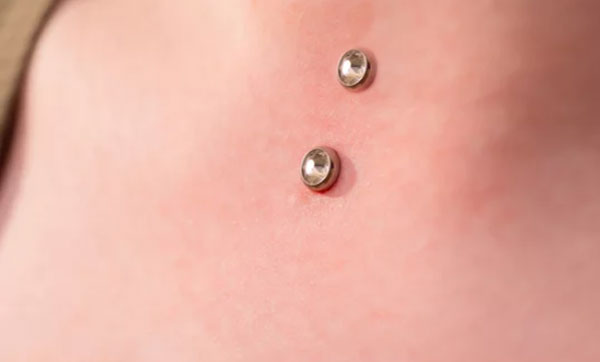Dermal Piercings

Dermal piercings, also known as microdermal or surface anchor piercings, are a type of body piercing that involves placing a single jewelry piece partially under the skin. Here's some information about dermal piercings:
Procedure:
- Placement: A small, flat base with holes (dermal anchor) is inserted under the skin through a small incision or with the help of a needle.
- Jewelry Attachment: Once the anchor is in place, the top part of the jewelry, known as the dermal top or dermal head, sits on the surface of the skin, allowing for decorative attachments.
Important Points:
- Placement Options: Dermal piercings can be placed on various parts of the body, including the face, chest, back, or anywhere with a flat surface suitable for placement. Common locations include the chest area, cheeks, forehead, or wrists.
- Professional Piercer: Dermal piercings require a skilled and experienced professional piercer who specializes in this technique. They will ensure proper placement, provide aftercare instructions, and use sterile equipment.
- Healing Process: Dermal piercings typically take several weeks to months to heal completely. During this time, it's crucial to follow the aftercare instructions provided by your piercer, such as cleaning the area with saline solution and avoiding trauma or excessive movement.
- Jewelry Options: Dermal piercings offer a wide range of jewelry options. The dermal tops come in various shapes, colors, and designs, allowing for customization and personalization.
- Removal and Migration: Dermal piercings are considered semi-permanent, as the anchors can be removed with the help of a professional piercer. However, there is a risk of migration (the piercing moving or shifting under the skin), and removing them without professional assistance can cause complications.
- Risks and Considerations: Like any piercing, dermal piercings carry risks of infection, rejection, scarring, and tissue damage. It's important to carefully consider the placement, consult with a professional piercer, and understand the potential risks associated with dermal piercings.
If you're considering a dermal piercing, it's crucial to consult with a professional piercer who can provide personalized advice, assess your anatomy, and guide you through the process. They will also educate you on the specific aftercare requirements to ensure proper healing and minimize the risks associated with dermal piercings.
 Mother's Day
Mother's Day Good Morning
Good Morning